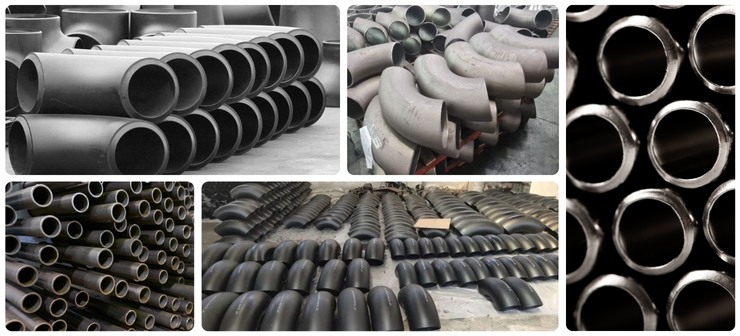
Carbon Steel Buttweld Fitting
Carbon steel buttweld fittings are an integral part of industrial piping systems, used to connect, branch, reduce, or change the direction of pipelines with high efficiency and strength. Manufactured using carbon steel and formed by the buttwelding process, these fittings provide smooth flow, leak-proof connections, and long service life. Known for their robustness and cost-effectiveness, they are extensively used in industries such as oil and gas, petrochemicals, refineries, power generation, shipbuilding, and water treatment.
Composition and Material Grades
The performance of carbon steel buttweld fittings is largely determined by their chemical composition and the grades used in manufacturing. Different standards and grades are available to suit varied applications:
♦ ASTM A234 Carbon Steel Buttweld Fittings are manufactured with a carbon content up to 0.30%, sulfur around 0.058%, silicon with a minimum of 0.10%, manganese between 0.29–1.06%, and controlled levels of chromium, molybdenum, nickel, copper, vanadium, and niobium. This balanced chemistry provides strength, toughness, and good weldability, making A234 fittings the most widely used in pressure piping and pressure vessel fabrication.
♦ ASTM A420 Low-Temperature Carbon Steel Buttweld Fittings are designed for sub-zero applications. They contain a maximum of 0.30% carbon, with sulfur at 0.058%, silicon not less than 0.10%, manganese between 0.29–1.06%, and low additions of nickel, molybdenum, and chromium. These fittings maintain excellent impact resistance and toughness at low temperatures, making them ideal for cryogenic and refrigerated piping systems.
♦ ASTM A860 High-Strength Carbon Steel Buttweld Fittings are engineered for high-pressure transmission services. Their composition includes manganese between 1.00–1.45%, silicon around 0.01%, nickel between 0.15–0.40%, chromium up to 0.50%, molybdenum at 0.30%, and small amounts of copper, titanium, vanadium, columbium (niobium), and aluminum. This alloying results in enhanced strength, hardness, and wear resistance, ensuring reliability under demanding service conditions.
Mechanical Properties
The mechanical strength of carbon steel buttweld fittings varies with grade:
♦ ASTM A234 WPB and WPC fittings exhibit tensile strength between 415–655 MPa, with excellent ductility and elongation. They are suitable for high-pressure, high-temperature service conditions.
♦ ASTM A420 WPL6 and WPC fittings show similar tensile strength ranges but are specifically formulated to retain strength and toughness at low and cryogenic temperatures.
♦ ASTM A860 fittings are designed for higher mechanical performance, offering tensile strength between 515–690 MPa, yield strength of 415 MPa, and elongation around 28%, making them suitable for high-pressure oil, gas, and transmission pipelines.
These properties ensure that carbon steel buttweld fittings maintain dimensional stability, withstand stress, and perform reliably across a wide temperature and pressure range.
Types of Carbon Steel Buttweld Fittings
Carbon steel buttweld fittings are manufactured in a variety of shapes and sizes to meet different piping requirements:
♦ Elbows (45°, 90°, 180°) – Used to change the direction of flow in pipelines.
♦ Reducers (Concentric & Eccentric) – Facilitate transition between different pipe diameters while maintaining flow efficiency.
♦ Tees (Equal & Reducing) – Allow branching of pipelines.
♦ Crosses – Provide four-way connections for complex pipeline layouts.
♦ Caps & Stub Ends – Used to seal or terminate pipeline ends.
♦ Bends – Allow smooth directional changes while minimizing pressure drop.
All these fittings are joined by welding, ensuring leak-proof and strong joints that integrate seamlessly into piping systems.
Applications of Carbon Steel Buttweld Fittings
Due to their strength, durability, and versatility, carbon steel buttweld fittings are widely used across industries. The oil and gas industry uses them in refineries, offshore platforms, and pipelines where high pressure and temperature are common. The petrochemical and chemical sectors rely on them for process piping systems handling corrosive and high-temperature fluids. In power generation, they are used in boilers, heat exchangers, and turbine piping systems. Shipbuilding, water treatment, and infrastructure projects also extensively employ carbon steel buttweld fittings for their reliability and cost-effectiveness.
Benefits of Carbon Steel Buttweld Fittings
♦ High strength and durability, suitable for critical piping systems
♦ Excellent weldability, ensuring reliable and leak-proof joints
♦ Cost-effective solution compared to stainless steel or exotic alloys
♦ Wide range of grades for ambient, low-temperature, and high-pressure applications
♦ Smooth internal surface, reducing pressure losses and turbulence in pipelines
♦ Long service life, even under harsh working environments
Conclusion
Carbon steel buttweld fittings are among the most widely used piping components in global industries due to their combination of strength, toughness, weldability, and affordability. Whether it is ASTM A234 for general pressure applications, ASTM A420 for low-temperature service, or ASTM A860 for high-strength, high-pressure applications, carbon steel buttweld fittings provide reliable performance in demanding conditions.
Their availability in multiple types and sizes makes them suitable for complex piping networks across oil and gas, petrochemical, power, and marine sectors. For industries seeking durable, economical, and high-performance piping solutions, carbon steel buttweld fittings remain the trusted choice worldwide.
Connect with us
All Materials
- SS Buttweld Fittings
- SS Forged Fittings
- Stainless Steel Flanges
- Inconel Buttweld Fittings
- Inconel Flanges
- Hastelloy Buttweld Fittings
- Hastelloy Forged Fittings
- Hastelloy Flanges
- Duplex Steel Buttweld Fittings
- Duplex Steel Forged Fittings
- Duplex Steel Flanges
- Monel Buttweld Fittings
- Monel Forged Fittings
- Monel Flanges
- Titanium Buttweld Fittings
- Titanium Forged Fittings
- Titanium Flanges
- Nickel Buttweld Fittings
- Nickel Forged Fittings
- Nickel Flanges
- Cupro Nickel Buttweld Fittings
- Cupro Nickel Forged Fittings
- Cupro Nickel Flanges
- Alloy Steel Buttweld Fittings
- Alloy Steel Forged Fittings
- Alloy Steel Flanges
- Carbon Steel Buttweld Fittings
- Carbon Steel Forged Fittings
- Carbon Steel Flanges
- AISI 4130 Pipe Fittings & Flanges
- SMO 254 Pipe Fittings & Flanges
- Alloy 20 Pipe Fittings & Flanges
Quality Pipe Fitting Solutions
Reliable, durable, and precise pipe fittings for every industrial need.





Buttweld Fittings
High-quality buttweld fittings for secure, leak-proof pipe connections.
Explore more




Flanges
Durable industrial flanges for reliable piping connection and pressure sealing.
Explore more




Threaded Fittings
Precision threaded fittings for secure, easy, and leak-resistant pipe connections.
Explore more




Socket Weld Fittings
Robust socket weld fittings for high-pressure, leak-proof pipe connections.
Explore more




Pre Fabricated Fittings
Custom pre-fabricated fittings for efficient, accurate, and time-saving piping installations.
Explore more




Fastners
High-performance fasteners for strong, reliable, and durable industrial connections.
Explore more




Pipes & Tubes
Premium pipes and tubes for efficient flow and structural reliability in industrial systems.
Explore more







Spades & Ring Spacers
Spades and ring spacers for safe pipeline isolation and maintenance operations.
Explore moreFAQs - Carbon Steel Buttweld Fitting
Carbon steel buttweld fittings are used to connect, branch, reduce, or change pipe direction, providing leak-proof, strong, and durable joints in industrial piping systems.
Industries such as oil and gas, petrochemicals, power generation, refineries, shipbuilding, and water treatment rely on carbon steel buttweld fittings for durability and performance.
Common grades include ASTM A234 for general applications, ASTM A420 for low-temperature service, and ASTM A860 for high-strength, high-pressure transmission pipelines.
They are produced by hot forming or forging carbon steel, followed by heat treatment and machining, ensuring strong joints, dimensional accuracy, and smooth internal surfaces.
They exhibit high tensile strength, good ductility, toughness, and excellent pressure resistance, making them reliable for ambient, low-temperature, and high-pressure piping systems.
Types include elbows, tees, reducers, crosses, caps, stub ends, and bends, designed to manage flow direction, branching, size changes, or pipeline terminations effectively.
They are cost-effective, strong, and durable, offering excellent weldability and performance in harsh environments, making them ideal compared to stainless steel or exotic alloys.
Yes, ASTM A420 low-temperature fittings are specially designed to maintain toughness, ductility, and leak-proof performance in cryogenic and refrigerated piping applications.
They offer high strength, corrosion resistance, long service life, smooth flow, leak-proof joints, and cost-effectiveness, ensuring reliable performance in critical piping networks.
They are manufactured according to international standards such as ASTM, ASME, ANSI, and MSS, ensuring global quality, dimensional accuracy, safety, and reliable performance.